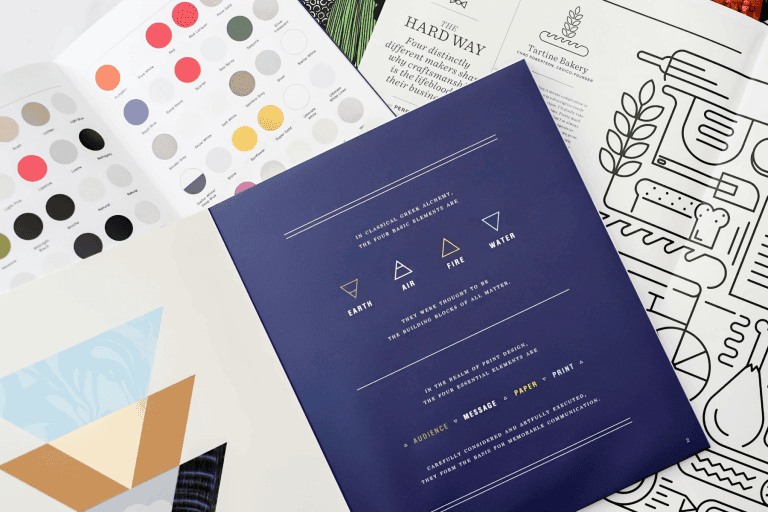It wasn’t long before Google claimed their share of the “story” format cake. Google Web Stories is the web version of social media stories (Snapchat, Facebook, Instagram). A blend of images, videos, animations, and text designed to create a dynamic viewing experience.
Since its announcement in 2019, Google is heavily pushing the adoption of this new feature to content creators. It is presented as an opportunity for businesses to incorporate a new kind of storytelling in their branding strategy.
Do you want to learn more about (re)branding?
(Re)branding your business will help you to align better with your target audience! How? We will discuss it in our free workbook.
As Google is testing out and shaping the future of visual storytelling on the web, they highly recommend you to try this new feature to grow organic traffic on your website and get more engagement on your content.
Let’s dive into everything you need to know about Google Web Stories and how to use them to grow your brand.

Google Web Stories and Discovery, a new home for your brand storytelling
Where do Google Web Stories appear?
Google Web Stories can be displayed:
- on your own website
- as a Google search result on mobile
- in Google Image as an image card
- in Google Discovery
About Google Discovery
Google Discovery is a mobile feed where users follow trends, creators, and brands they care about. It is the new home for Web Stories.
Discovery redefines the search experience based on social media models. In this browsable feed, you don’t type a search query, content surfaces based on your interests.

Getting the front cover in Discovery can boost your website organic traffic tremendously, as we’ll see later on. On top of that, Google Discovery is also available as a placement for ad campaigns.
What are Google stories made of?
Google Web Stories offer a similar experience to Facebook or Instagram stories. It’s a mobile-first, animated format. Successive images, text, audio, and/or videos are animated to tell a short and impactful story. It’s a full-screen and immersive experience.
Just like in social media, viewers can swipe back and forth between pages and access external content through embedded links. Google Web Stories also include interactive elements such as polls or quizzes, and links to external content can be added.
However, there are a few major differences between the traditional social media stories and Google Web Stories format. These make the latter a powerful marketing tool:
Permanent: Google Stories are not limited in time, they stay online for as long as you want them to. You can set up a live duration when creating your story if you want them to be ephemeral.
Owned by you: Google Web Stories are published on your own website, they are hosted on your website server and are created and managed with a plugin in your content management system.
Open on the web: This story format is not confined to a single platform. Web stories are similar to web pages, they are not tied to an app and are easily shareable with a link. They can be seen anywhere a web page can be seen.
Monetizable: Owning the content of your stories gives you 100% of the revenue. You can display ads of affiliate links in your stories to generate revenue.
Sharing the brand content: the web search is going visual
With Google Web Stories, brands can create a complete narrative to promote their product and services.
“Instead of writing 1,000 words, you can combine photos, quotes, video, infographics and text to viscerally change the way you communicate with your reader.”
Source: “Bustle Digital Group gives digital natives content they crave”
It’s no secret that visual content receives more engagement than texts. For this reason, Google believes visual stories will be a pillar of the web media landscape.
Digital native audiences spend hours a day on their phone. They are looking for engaging and immersive forms of content, beyond the traditional format. Stories offer a mix of media and interactive experiences to communicate the brand’s story.
Example of amazing Google Web “Brand Stories”
With Google Web Stories, visual storytelling is made easy and inexpensive. Both independent creators and large brands are using it to boost user engagement. In general, industries with aspirational imagery such as lifestyle, art,entertainment, or food industries get the most impressions.
Here are a few examples of successful Google Web Stories creators:
Bustle Digital Group partnered with Google to launch Google Web Stories. They have already created hundreds of stories based on their existing blog articles. In their story “9 genius morning routines for people who WFH”, they use powerful imagery and quotes to create an engaging piece of content.
This food blog really took advantage of this special format. After a couple of months creating stories, Lauren managed to increase the blog organic traffic from 100k monthly page views to over 700k for the same time period. An incredible growth that changed the dynamic of her website.
With The historic SpaceX launch of NASA astronauts Bob Behnken and Doug Hurley, The Washington Post retraces the launch of the SpaceX rocket in a very human and emotionally engaging manner.
The subtle mix of images, videos, and text-only pages shows the perfect example of a successful Web Story.

Where to start with creating your stories?
Google Web Stories lower the barriers to creating great visual content. Choose an article, powerful images, and use the WordPress plugin to create them. Chances are you already have great articles on your blog or social media campaigns that you can use to create content on Google Web Stories.
Don’t miss out on this opportunity to expose your content to a broader audience and boost your website’s organic traffic. Not sure where to start? We’re happy to help!








